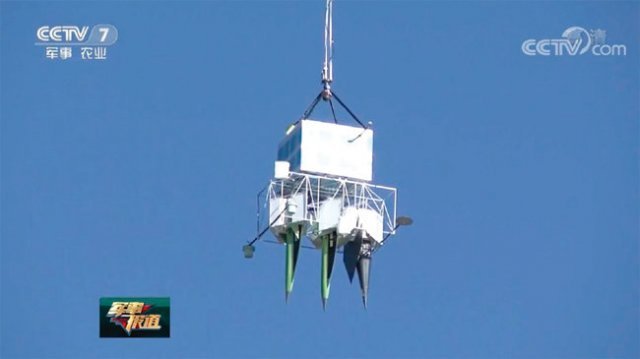A reconnaissance balloon that is more useful than a satellite… Chinese newspaper “It will be a creepy killer like a deep-sea submarine”
As the U.S. shot down a Chinese reconnaissance balloon that invaded its airspace, the conflict between the two countries is escalating, and attention is focused on China’s intention to operate the reconnaissance balloon. The US Department of Defense announced that it shot down a Chinese reconnaissance balloon floating at an altitude of 18-20 km with an AIM-9 air-to-air missile using an F-22 stealth fighter in the airspace off the coast of South Carolina at 2:39 pm on February 4 (local time). did. “The Chinese reconnaissance balloon, the size of three buses combined, began flying near the Aleutian Islands between Russia’s Kamchatka Peninsula and Alaska in the United States on January 28, passed through Canada, entered U.S. airspace, and passed through the Northwest U.S. mainland,” Defense Ministry spokesman Patrick Ryder said. He said, “This is a violation of international law.”
There are nuclear weapons hangars and military bases in the Northwest region of the United States, such as Malmstrom Air Force Base in Montana and Minoh Air Base in North Dakota, where strategic bombers and 150 intercontinental ballistic missiles (ICBMs) are deployed. In this regard, a senior U.S. Department of Defense official said, “According to high-resolution images taken by the U-2 reconnaissance aircraft, the Chinese balloons are for reconnaissance with the ability to collect signal information.” no,” he said. The official also revealed that “Chinese reconnaissance balloons were equipped with multiple antennas to collect communications and determine geographic location, as well as large solar panels to generate the power needed to operate multiple active intelligence-gathering sensors.”
 Soldiers from the US Navy Explosive Ordnance Squad collect debris from a Chinese reconnaissance balloon on February 4 (local time). blue
Soldiers from the US Navy Explosive Ordnance Squad collect debris from a Chinese reconnaissance balloon on February 4 (local time). blueJudging from the announcements made by the US Department of Defense, the reason why China sent reconnaissance balloons to the US can be said to be for the purpose of collecting information. China, which meticulously monitors U.S. military installations through spy satellites, operates reconnaissance balloons because of the advantages of reconnaissance balloons. First of all, scout balloons can be photographed from a closer distance than satellites and can intercept communications or electronic signals. It is also capable of steering and can stay in one place for a long time. In addition, scout balloons are made of fabric, making them difficult to detect and identify. It appears on radar as a small, bird-sized object. It is difficult to distinguish them from private meteorological balloons. It is cheaper and has better cost-effectiveness than satellite. The People’s Liberation Army’s official magazine, the People’s Liberation Army, said, “Reconnaissance balloons are the powerful eyes of the sky,” and predicted, “In the future, the balloon program will become a thrilling hidden killer like a deep-sea submarine.”
On February 9, the US government officially announced that China had sent intelligence-gathering scout balloons to more than 40 countries on five continents, including North America, South America, Southeast Asia, East Asia and Europe. It also said that the downed Chinese reconnaissance balloon was equipped with equipment capable of detecting and collecting intelligence signals. In particular, the U.S. government pointed out that the People’s Liberation Army of China was behind the operation of the reconnaissance balloon and declared that it would take strong action against the act of violating its sovereignty. Prior to this, U.S. Deputy Secretary of State Wendy Sherman held a briefing session on Chinese reconnaissance balloons for 150 diplomats from 40 countries, including South Korea, stationed in Washington on February 6. The briefing was held behind closed doors, but Deputy Secretary Sherman is said to have briefed her that China has been operating a large-scale air surveillance program using reconnaissance balloons and has links to the People’s Liberation Army.
The US media pointed out that “the reconnaissance balloon was developed by the Institute of Space Technology under the Chinese Academy of Sciences, a research institute directly under the Chinese government,” and that “the ‘Strategic Support Unit’ in charge of space and cyberspace in the People’s Liberation Army of China has been in charge of its operation.” . The Strategic Support Unit is a unit in charge of electronic warfare, space warfare, and cyber warfare.
In this regard, the US’Washington Post (WP) said, “China has been operating a reconnaissance balloon unit as its base in Hainan Province near the South China Sea.” We have been monitoring military assets in the targeted areas.” Also, ‘The New York Times (NYT)’ pointed out, “The People’s Liberation Army of China has been developing weapons and strategies that can create a surprise effect while striving to modernize the military.” “The reconnaissance balloon is one of them.” The Wall Street Journal (WSJ) reported that “the balloons were made by the Zhuzhou Rubber and Design Institute in Henan Province.”
Zhang Tianliang, a former professor at George Mason University in the US who has criticized China’s one-party system, said, “The claim that the Chinese government has been using balloons for civilian meteorological research is absolutely ridiculous.” Igo Zhuzhou Research Institute holds a second-class license for weapons and equipment research and production.” On the other hand, the Chinese government is protesting, saying, “A civilian balloon for scientific research accidentally entered US airspace, but the US is conducting a self-made play by turning it into a reconnaissance balloon for political purposes.”
Some point out that China is using reconnaissance balloons for purposes other than intelligence gathering. CNN broadcast pointed out that the People’s Liberation Army of China considers the area called ‘near space’ as a ‘new battlefield in the 21st century’ with the United States and is operating reconnaissance balloons. The near universe is a term that combines the stratosphere and the mesosphere, and in China it is called ‘Linguo Space’.
Earth is enclosed in a layer of air called the atmosphere. The atmosphere is divided into four types according to the change in temperature at different altitudes. The troposphere extends from the surface to 12 km, the stratosphere from 12 to 50 km, the mesosphere from 50 to 80 km, and the thermosphere from 80 to 700 km. The exosphere is the outermost layer of the earth’s atmosphere, at altitudes between 700 and 10,000 km. Below it is bordered by the thermosphere, and outside the exosphere is outer space. The space in which artificial satellites operate is the exosphere and outer space.
 China’s state-run CCTV unveiled a reconnaissance balloon loaded with a model of a hypersonic missile in 2019. CCTV
China’s state-run CCTV unveiled a reconnaissance balloon loaded with a model of a hypersonic missile in 2019. CCTV Chinese reconnaissance balloon specifications and operating altitude released by the BBC. BBC broadcast
Chinese reconnaissance balloon specifications and operating altitude released by the BBC. BBC broadcastNear space is an intermediate space located above the altitude where military aircraft such as fighters and bombers and civil aircraft operate and below the altitude where artificial satellites orbit. Hypersonic missiles and ICBMs pass through near space at an altitude of 12 to 80 km. For this reason, the Chinese military has paid attention to the military value of the near space from 2018 to 2020. Chinese military experts argued that it is important to take the lead in near space because it could become a new battlefield against the West, including the US. In fact, the West, including the United States, has developed solar-powered drones and hypersonic vehicles, and has been seeking ways to use them in near space.
It is for this reason that China conducted the first test flight of its self-developed solar-powered unmanned reconnaissance drone ‘Qimingxing (?明星)50’ in September last year. This unmanned reconnaissance drone with a wingspan of 50 m can fly up to 20 km. China has become the third country to have solar-powered unmanned drones after the US Helios and the UK Zephyr. “These unmanned drones will be used not only for military high-altitude reconnaissance, but also for missions similar to those of satellites, such as geographic surveying and communications,” said Zhu Shengli, senior researcher at China Aviation Industry Group. In this context, it can be said that the Chinese military operates reconnaissance balloons for the same purpose.
The Institute of Space Technology under the Chinese Academy of Sciences, established by the Chinese government, is accelerating research to secure leadership in near space by developing high-altitude balloons and stratospheric airships. In fact, Chinese scientists have published about 1,000 papers on the near universe so far. Chinese scientists, in particular, are using reconnaissance balloons to collect data that could help develop hypersonic weapons that can penetrate near space. Because of this, the US government sees gathering information about atmospheric flow as another task for scout balloons. Satellites cannot collect the atmospheric data necessary for China’s missile operations, but reconnaissance balloons can. Carl Schuster, former director of operations for the Joint Intelligence Center at the U.S. Pacific Command, pointed out, “It is very important to understand atmospheric conditions in near space in order to create ballistic and hypersonic missile guidance software.”
The US government is responding tougher than ever to the Chinese reconnaissance balloon incident. Secretary of State Tony Blincoln was scheduled to visit China on February 5-6 to discuss international issues, including bilateral relations, but postponed it indefinitely. This can be seen as sending a warning message to China. President Joe Biden also declared in his second State of the Union address after taking office on February 7, “If China threatens our sovereignty, we will act to protect the country.” The U.S. government imposed sanctions, including listing five companies and one research center related to Chinese reconnaissance balloons on the list of export sanctions. In addition, it is clear that the US government will also engage in research related to near space as well as weapon development using it. As a result, Geunju is expected to become a new competitive arena between the United States and China in the future.
[이 기사는 주간동아 1377호에 실렸습니다]
Janghoon Lee International Affairs Analyst [email protected]
Source: Donga
Mark Jones is a world traveler and journalist for News Rebeat. With a curious mind and a love of adventure, Mark brings a unique perspective to the latest global events and provides in-depth and thought-provoking coverage of the world at large.